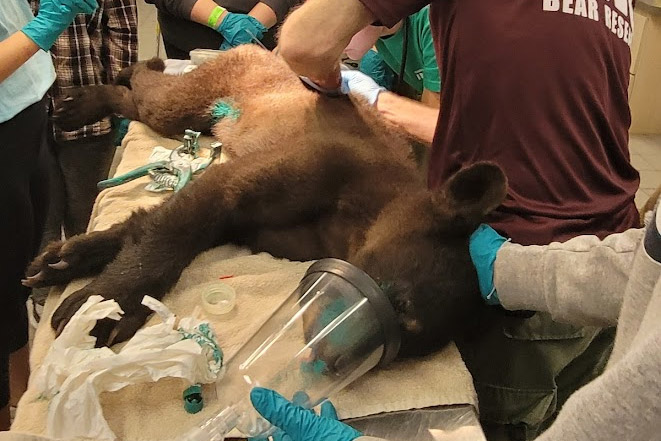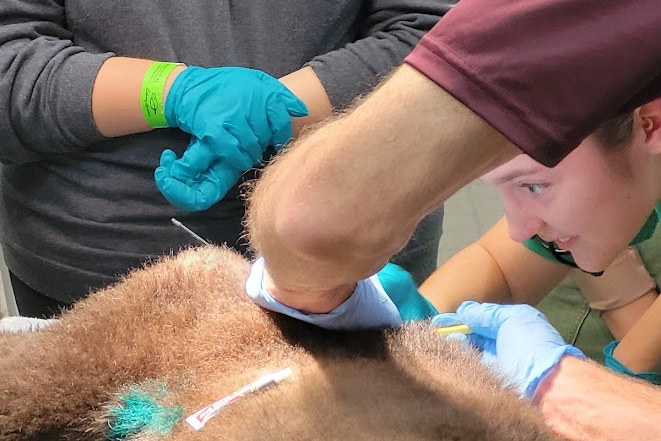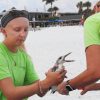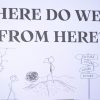
Eckerd College students work with Florida Fish and Wildlife Conservation Commission bear researcher Brian Scheick to attach a radio transmitter to a black bear cub.
From a wildlife standpoint, it’s one of the few places in Florida that literally has it all, insists Ray Ball, visiting assistant professor of biology at Eckerd College and a doctor of veterinary medicine.
“The park is probably the best place in the state to go see almost every animal that lives in Florida—bears, bobcats, birds, snakes, raccoons, armadillos … It’s a very natural habitat. The animals just blend in there.”
Ball is talking about the Ellie Schiller Homosassa Springs Wildlife State Park, about 85 miles north of St. Petersburg along the Gulf Coast. The 150-acre park has been a tourist attraction since the early 1900s, and the Citrus County Commission voted in 1984 to purchase it and then turned it over to the State.
What better place, Ball says, for his wildlife rehabilitation students to get hands-on experience caring for and treating a wide variety of animals. Ball has been working at the park on and off in some capacity as a veterinarian since he graduated from college. Most of the animals he treats are either sick, injured or orphaned and can’t be immediately returned to the wild.
Senior Olivia Felicia glues a radio transmitter to the fur of the cub.
The park also is one of the prime rehabilitation facilities in Florida for orphaned black bear cubs. “It’s about raising them in a way where they don’t associate food with people,” Ball says. “We have two that are going to be released in the next six weeks, and we just got another one.”
Time for a road trip. Eight students from Ball’s wildlife rehab class, a course in the Animal Studies major, made the 90-minute drive to Homosassa on Nov. 9 to watch, learn and lend a hand. “They went with me on my rounds,” Ball says. “Several of the students have experience working in veterinary hospitals, so it was easy to adapt their experience to this. Others had a stronger interest in the conservation messaging that rehabilitation provides. All of them rotated through the various tasks involved.
“You can’t really appreciate an animal unless you can see it up close, smell it, touch it … you have to make that personal connection,” Ball adds. “The students get excited at first, then they’re asking questions, and then they’re doing everything else themselves.”
On this visit, a researcher from the Florida Fish and Wildlife Conservation Commission (FWC) was working on a method to attach a radio transmitter to the three sleeping cubs while Ball was monitoring them. “My role was to maintain a safe level of anesthesia, perform a health evaluation and collect blood samples for health analysis,” he says.
A quick word about the Florida black bear. Adult males weigh about 300 pounds, females about half as much. They are reclusive, will eat just about anything, and there are an estimated 4,000 of them in the state. Mothers typically give birth to two cubs that will stay with her for more than a year. Black bears are not on the Endangered Species list, but Florida law makes it illegal to kill one without a permit.
So … in 2015, the FWC authorized a bear hunt, the first in more than 20 years. Nearly 3,800 permits were sold, more than the entire estimated population of bears at the time. After the two-day hunt was over, 304 bears were killed, mostly in the Panhandle and Ocala areas. The next year, facing a growing public outcry, the FWC voted to postone bear hunting.
At least for now, the class’s last planned wildlife rehab session at the park was Dec. 1. Ball says there may be more trips in the spring. This is fine with students like Olivia Felicia, a senior animal studies student from Medford, New Jersey. During last month’s visit, she performed medical assessments on the bears and helped tag them.
“To take the skills we’ve learned and apply them to treating the bears was a really great learning experience for everyone in the class,” says Olivia, who also works for a veterinarian in Bradenton.
“Dr. Ball always says the best way to learn about animals is to get in there with them. And when you do, you realize this is a world we’re sharing with them, and that animals need people to advocate for them.”















